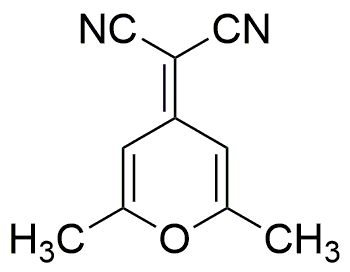4-(Dicyanomethylene)-2,6-dimethyl-4H-pyran is widely utilized in research focused on:
- Organic Synthesis: This compound serves as a versatile building block in organic chemistry, enabling the synthesis of various complex molecules, which is essential for developing new pharmaceuticals and agrochemicals.
- Fluorescent Dyes: It is used in the production of fluorescent dyes, which find applications in biological imaging and diagnostics, providing researchers with tools to visualize cellular processes.
- Material Science: The compound is incorporated into polymer formulations to enhance properties such as thermal stability and UV resistance, making it valuable in the development of advanced materials.
- Photovoltaic Devices: It plays a role in the formulation of organic solar cells, contributing to improved efficiency and stability, which is crucial for the advancement of renewable energy technologies.
- Analytical Chemistry: This chemical is utilized in various analytical methods, including chromatography, to separate and identify compounds, aiding researchers in quality control and product development.
General Information
Properties
Safety and Regulations
Applications
4-(Dicyanomethylene)-2,6-dimethyl-4H-pyran is widely utilized in research focused on:
- Organic Synthesis: This compound serves as a versatile building block in organic chemistry, enabling the synthesis of various complex molecules, which is essential for developing new pharmaceuticals and agrochemicals.
- Fluorescent Dyes: It is used in the production of fluorescent dyes, which find applications in biological imaging and diagnostics, providing researchers with tools to visualize cellular processes.
- Material Science: The compound is incorporated into polymer formulations to enhance properties such as thermal stability and UV resistance, making it valuable in the development of advanced materials.
- Photovoltaic Devices: It plays a role in the formulation of organic solar cells, contributing to improved efficiency and stability, which is crucial for the advancement of renewable energy technologies.
- Analytical Chemistry: This chemical is utilized in various analytical methods, including chromatography, to separate and identify compounds, aiding researchers in quality control and product development.
Documents
Safety Data Sheets (SDS)
The SDS provides comprehensive safety information on handling, storage, and disposal of the product.
Product Specification (PS)
The PS provides a comprehensive breakdown of the product’s properties, including chemical composition, physical state, purity, and storage requirements. It also details acceptable quality ranges and the product's intended applications.
Certificates of Analysis (COA)
Search for Certificates of Analysis (COA) by entering the products Lot Number. Lot and Batch Numbers can be found on a product’s label following the words ‘Lot’ or ‘Batch’.
Numéro de catalogue
Numéro de lot/série
Certificates Of Origin (COO)
This COO confirms the country where the product was manufactured, and also details the materials and components used in it and whether it is derived from natural, synthetic, or other specific sources. This certificate may be required for customs, trade, and regulatory compliance.
Numéro de catalogue
Numéro de lot/série
Safety Data Sheets (SDS)
The SDS provides comprehensive safety information on handling, storage, and disposal of the product.
DownloadProduct Specification (PS)
The PS provides a comprehensive breakdown of the product’s properties, including chemical composition, physical state, purity, and storage requirements. It also details acceptable quality ranges and the product's intended applications.
DownloadCertificates of Analysis (COA)
Search for Certificates of Analysis (COA) by entering the products Lot Number. Lot and Batch Numbers can be found on a product’s label following the words ‘Lot’ or ‘Batch’.
Numéro de catalogue
Numéro de lot/série
Certificates Of Origin (COO)
This COO confirms the country where the product was manufactured, and also details the materials and components used in it and whether it is derived from natural, synthetic, or other specific sources. This certificate may be required for customs, trade, and regulatory compliance.


